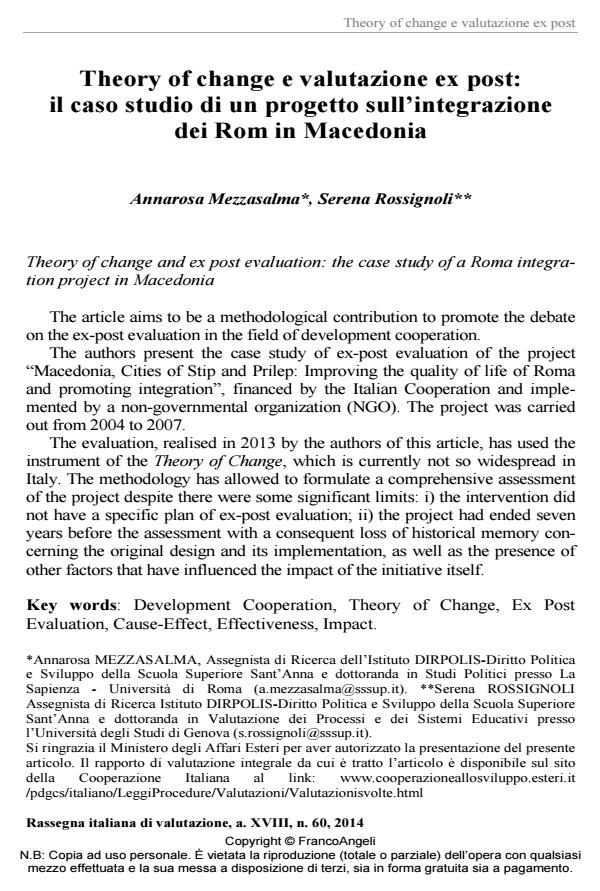Theory of change and ex post evaluation: the case study of a Roma integration project in Macedonia
Journal title RIV Rassegna Italiana di Valutazione
Author/s Annarosa Mezzasalma, Serena Rossignoli
Publishing Year 2015 Issue 2014/60
Language Italian Pages 21 P. 24-44 File size 130 KB
DOI 10.3280/RIV2014-060003
DOI is like a bar code for intellectual property: to have more infomation
click here
Below, you can see the article first page
If you want to buy this article in PDF format, you can do it, following the instructions to buy download credits

FrancoAngeli is member of Publishers International Linking Association, Inc (PILA), a not-for-profit association which run the CrossRef service enabling links to and from online scholarly content.
The article aims to be a methodological contribution to promote the debate on the ex-post evaluation in the field of development cooperation. The authors present the case study of ex-post evaluation of the project "Macedonia, Cities of Stip and Prilep: Improving the quality of life of Roma and promoting integration", financed by the Italian Cooperation and implemented by a non-governmental organization (NGO). The project was carried out from 2004 to 2007. The evaluation, realised in 2013 by the authors of this article, has used the instrument of the Theory of Change, which is currently not so widespread in Italy. The methodology has allowed to formulate a comprehensive assessment of the project despite there were some significant limits: i) the intervention did not have a specific plan of ex-post evaluation; ii) the project had ended seven years before the assessment with a consequent loss of historical memory concerning the original design and its implementation, as well as the presence of other factors that have influenced the impact of the initiative itself.
Keywords: Development Cooperation, Theory of Change, Ex Post Evaluation, Cause-Effect, Effectiveness, Impact
- Vogel I. (2012). Review of the use of ‘Theory of Change’ in International development. UK Department of International Development.
- James C. (2011). Theory of Change Review. Comic Relief.
- Consiglio d’Europa (2010). Proteggere i diritti dei Rom.
- European Commission (2013). The Former Yugoslav Republic of Macedonia 2013 Progress Report. SWD(2013) 413 final.
- European Roma Rights Centre (2013). Macedonia Country Profile 2011-2012.
- Leeuw F. L., Vaessen J. (2009). Impact evaluations and development: NONIE guidance on impact evaluation. Nonie.
- Morra Imas, L.G., Rist, R.C. (2009). The Road to Results: Designing and Conducting Effective Development Evaluations. World Bank.
- OECD-DAC (1991). Principles for the Evaluation of Development Assistance. Paris: OECD.
- Open Society Institute Report (2010). No Data - No Progress. Data Collection in Countries Participating to the Decade of Roma Inclusion 2005-2015.
- Weiss, Carol (1995). Nothing as Practical as Good Theory: Exploring Theory-Based Evaluation for Comprehensive Community Initiatives for Children and Families in New Approaches to Evaluating Community Initiatives. Aspen Institute.
- Roma Education Fund (2004). Needs Assessment Study for the Roma Education Fund. Background paper. Republic of Macedonia.
- State Statistical Office - Republic of Macedonia (2005). Census of Population, Households and Dwellings in the Republic of Macedonia. 2002. Book XIII.
- Ministry of Labour and Social Policy - Republic of Macedonia (2011). Strategy for intensifying of the social inclusion of Roma in the social protection system in the Republic of Macedonia for the period 2012-2014.
- Ministry of Labour and Social Policy - Republic of Macedonia (2004). Strategy for Roma in the Republic of Macedonia.
- UNICEF (2007). Breaking the cycle of exclusion. Roma children in South East Europe. UNDP, WB, European Commission (2011). Regional Roma Survey.
Annarosa Mezzasalma, Serena Rossignoli, Theory of change e valutazione ex post: il caso studio di un progetto sull’integrazione dei Rom in Macedonia in "RIV Rassegna Italiana di Valutazione" 60/2014, pp 24-44, DOI: 10.3280/RIV2014-060003